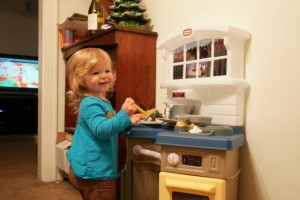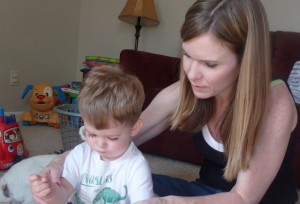Just What IS “W-Sitting”? And Why Should I Discourage My Child from Sitting This Way?
March 15, 2016April Family Friendly Community Events
March 31, 2016By Dave Hammer, MA CCC-SLP
Director of Professional Development and Speech Services
Childhood Apraxia of Speech Association of North America
As a specialist in childhood apraxia of speech (CAS), I get to talk to a lot of parents throughout the country about their most pressing questions regarding the diagnosis and treatment of this complex motor speech disorder. In this blog, I would like to talk specifically about what I hear and how I respond when I get questions from parents who have children in the 0-3 age range.
How young is too young to diagnose CAS?
There is no way that we can put an age level on this answer. We all know precocious 2-year-olds that try very hard to talk and demonstrate features such as lack of early sound play, groping, inconsistency, and limited sound repertoire. The diagnosis of “suspected CAS” (sCAS) was supported by the AdHoc committee of ASHA in the 2007 position statement and technical report (for which I was a committee member). This ensures that a therapist attends to the speech sound and sound sequencing issues while at the same time knowing that the diagnosis may not hold over time. It can do no harm with this approach while it may be detrimental if we wait until we feel more convinced of the diagnosis and not treat the speech sound production and sound sequencing symptoms that are present.
What are the critical features to look for that may result in a diagnosis of suspected CAS?
Parents often are the first to become aware that there is something not quite right with their child’s speech development. There are many well-intending relatives, friends, and even medical professionals who offer suggestions to “wait” since there is a chance that the child will “grow out of it”. We hear countless stories of how parents were told that “so and so did not talk until he was 5 and he is very successful” or” Einstein did not talk until he was…” (and that usually is one year older than what the child is at the time!). I always try to support parents in trusting their instincts. An early possible indicator is the lack of babbling and sound play. So much of the foundation for speech development happens in the pre-verbal stages of cooing and babbling. Without this sound play (usually accompanied by mouthing of toys, objects, and their own body parts while vocalizing), the child does not lay down critical speech motor planning and sensory feedback foundational skills. Of course, getting the child’s hearing checked is the first step to make sure that the child is hearing the sounds for speech adequately. Another feature to look for is the lack of a variety of sounds, even if the child is babbling. As children approach one, you should hear a wide range of consonants and vowels in their sound play.
Why can’t the therapist tell me for sure if my child has CAS?
In this age range, there are many factors that complicate the definitive diagnosis of CAS. One is that we usually can only get a limited sample of speech attempts on which to try to base a diagnosis. We can’t and should not diagnose CAS when a child is simply pointing and “grunting” without more evidence of word attempts that lead to indicators of motor planning struggles. Another complicating factor is that children in this age group are often starting or in the midst of the “Declaration of Independence” stage of development (I avoid calling it the “Terrible Two’s” as it is important for children to go through it at this age and not wait until they are 13 where it truly can me more traumatizing!). This makes it challenging to sort out inability from unwillingness to try. Many children experiencing speech and language delays become non risk-takers with respect to their verbal attempts and therefore, shut down or resort to an “all-purpose” sound or to nonverbal means of communicating their needs. This again leads to a limited sample on which to diagnose.
Look for Part Two of Diagnosis and Treatment of Childhood Apraxia of Speech (CAS) in our next TEIS Blog!




 Send to a friend!
Send to a friend!